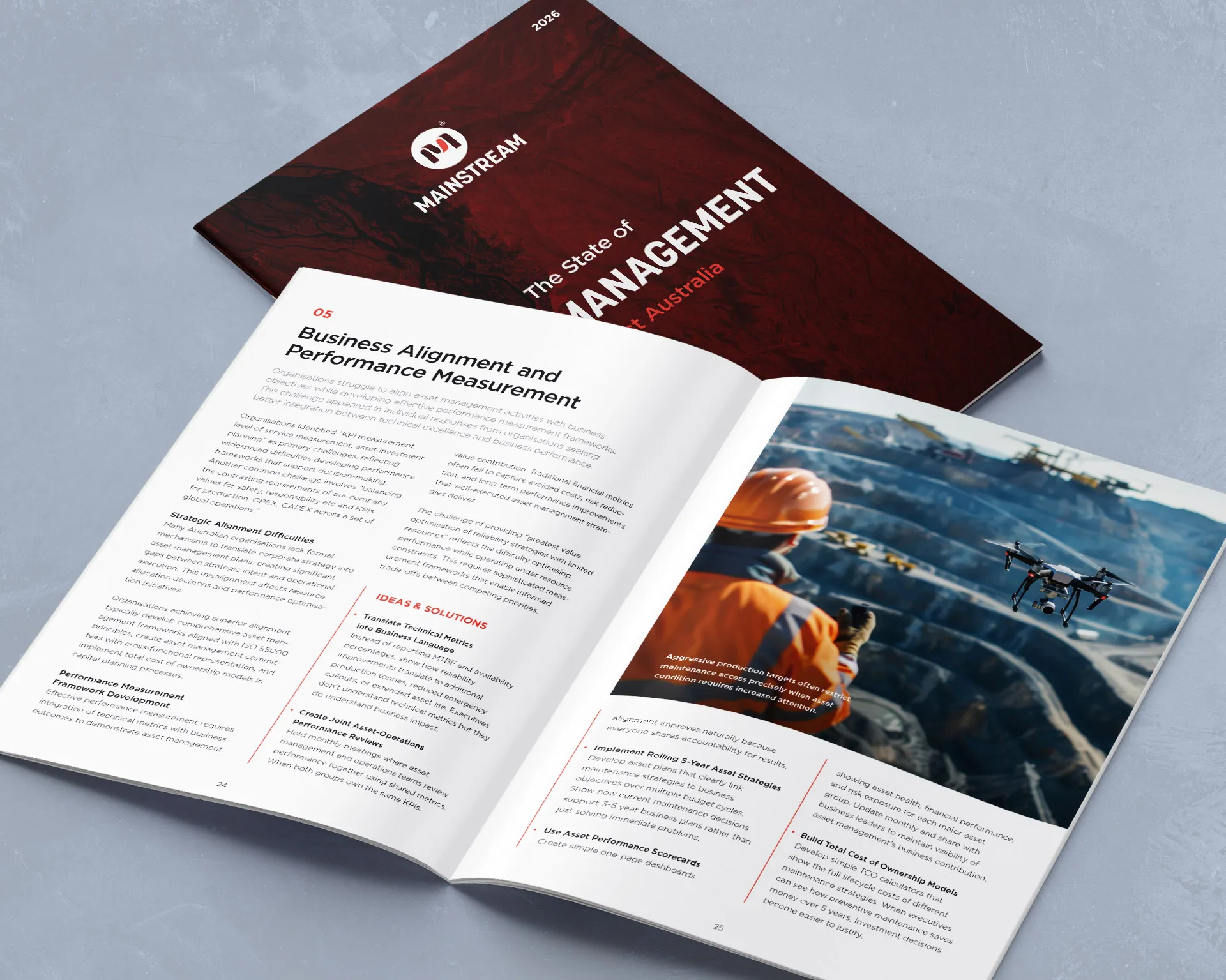Hot
Topics
MAINSTREAM researched 210 Asset Management, Maintenance and Reliability leaders across 52 WA companies. This definitive 48-page report reveals the top 12 obstacles to excellence - and how WA's leading companies are overcoming them. Benchmark your performance, learn from the best, and make decisions that drive results.
Download Report
Data Governance, Quality and Utilisation
Maintenance professionals spend 38% of time on data activities rather than value-adding work. Despite collecting vast quantities of information, teams struggle to extract strategic value or improve decision-making, drowning in poor-quality data without clear governance frameworks.
System Integration and Technology Transition
Typical operations involve many disparate systems containing critical asset information, creating inefficiencies as technicians navigate between platforms. System transitions frequently cause data quality degradation, with previously mandatory fields becoming optional and comprehensive practices abandoned during implementation.
Work Management Standardisation and Consistency
Despite decades of standardised processes, compliance remains inconsistent across sites and teams. A costly misconception persists: implementing standardised systems will automatically generate standardised practices, overlooking accountability mechanisms and cultural factors that determine actual behaviour.
Financial Justification and Resource Allocation
Mounting pressure to deliver more with fewer resources challenges operations managing increasing complexity. Budget reduction mandates arrive without implementation guidance, forcing reactive cost-cutting without strategic consideration of operational consequences or long-term asset sustainability.
Business Alignment and Performance Measurement
Asset management activities struggle to align with business objectives while effective performance frameworks remain elusive. Traditional financial metrics fail capturing avoided costs and risk reduction, making it difficult to demonstrate asset management's value contribution to business outcomes.
AI Integration and Adoption Barriers
While 72% of asset-intensive companies explore AI in maintenance, 76% of initiatives fail achieving expected returns. Infrastructure limitations, cultural acceptance challenges, and fundamental questions about human-AI collaboration create barriers beyond technical capabilities, undermining implementation success.
Workforce Capability and Knowledge Preservation
Critical shortages span multiple technical domains while workforce transitions threaten institutional knowledge preservation. The aging workforce creates knowledge transfer urgency, with significant technical expertise remaining undocumented and resident with experienced personnel approaching retirement.
Reliability Function Positioning and Development
Reliability engineering lacks recognition as a distinct profession in Australia, with limited career pathways and unclear organizational expectations. Practitioners spend time firefighting rather than systemic improvement, while struggling to demonstrate value contribution and secure organizational influence.
Maintenance Planning and Execution Excellence
Comprehensive work management processes exist but consistent execution proves elusive. Significant gaps between documented processes and actual practice persist, with Australian operations achieving significantly lower wrench time compared to international benchmarks due to planning and scheduling deficiencies.
Human-Centred Maintenance: Workforce Wellbeing and Inclusivity
Mental health challenges affect maintenance professionals 23% more than the general workforce, particularly FIFO and remote workers. Women represent only 16.8% of the maintenance workforce, constraining innovation and problem-solving effectiveness while limiting talent pool access.
Decarbonisation and Sustainability Pressures
Industrial decarbonisation requires modifying or replacing approximately $893 billion in existing Australian assets by 2050. Hybrid portfolios combining traditional and low-carbon technologies create complex transition challenges with urgent new skill requirements and unprecedented asset management complexity.
Integration of Safety, Risk, and Asset Management
Safety management, risk assessment, and asset maintenance processes struggle to integrate effectively, operating with different systems and frameworks. With 27% of serious workplace incidents having maintenance-related contributing factors, critical connections remain systematically unaddressed across the industry.

The State of Asset Management
Download your report to understand best practices, compare your companies’ performance and working environment to those inside and outside your industry, and make informed and effective decisions around your assets and your people.








